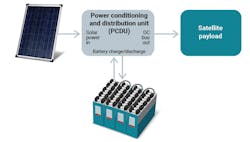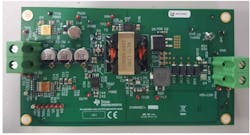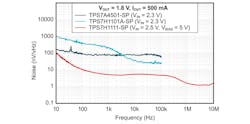PWM Controllers Plus LDO Regulators Boost Satellite Performance
Members can download this article in PDF format.
Electronic assemblies headed for space must exhibit minimal size, weight, and power (SWaP) to reduce launch costs and effectively use limited solar-panel or other energy-source outputs. Nevertheless, the circuitry must meet mission requirements for specifications such as data transmission rate, resolution, and sensitivity.
Space-grade pulse-width-modulation (PWM) controllers and low-dropout (LDO) regulators can form the basis for effective space-bound designs, balancing low-noise and high-efficiency performance as required throughout the many subsystems in a modern satellite.
PWM Controllers
Maximizing satellite efficiency begins with the design of an electrical power system (EPS), which typically includes the following functions (Fig. 1):
- Solar panels—the primary power sources for most satellites.
- A battery for storing excess energy when the solar panels are exposed to the sun and for powering the satellite when the panels are dark.
- A power conditioning and distribution unit (PCDU) that regulates solar-panel or battery output and distributes the required stable voltage to the electronic subsystems that populate the satellite payloads.
PWM controllers, which combine with power transistors to form switching power supplies, play key roles in satellite power conditioning and distribution as well as within each payload. The controllers can work with power transistors in synchronous-buck, flyback, full-bridge, and other topologies to handle the wide range of voltages and currents required by a satellite (Fig. 2).
Specific controllers suitable for such applications include Texas Instruments’ radiation-hardened TPS7H5001-SP and radiation-tolerant TPS7H5005-SEP dual-output PWM controllers with synchronous rectification. Both support multiple topologies, run on 4- to 14-V inputs, and operate at switching frequencies from 100 kHz to 2 MHz.
TI offers several PWM-controller reference designs to get you started optimizing SWaP for satellite power systems. One describes using the TPS7H5001-SP in a 200-W non-isolated synchronous-buck topology that supports an input of 50 to 150 V with an output of 28 V (Fig. 3). This design converts the variable output of solar panels nominally rated at 100 V down to 28 V, distributing the regulated 28-V output to battery-charging and other circuitry.
Another reference design describes the TPS7H5001-SP in an isolated flyback converter that converts a 28-V input to a 5-V, 10-A output. A third describes a non-isolated design using the TPS7H5001-SP in a single-phase synchronous buck topology to convert an 11- to 14-V input to 1-V output at up to 20 A.
You can extend that third design to a multiphase topology that can deliver 50 A at 1 V to components such as advanced FPGAs and multicore central-processing units. In addition to the reference designs, TI offers evaluation modules that let you experiment further with the TPS7H5001-SP and TPS7H5005-SEP.
Minimizing Noise with LDOs
Many satellites incorporate data converters and analog components that require very low-noise voltages typically only available from linear power supplies. Linear supplies inherently offer lower efficiencies than switching supplies, but you can use a linear LDO regulator to minimize the efficiency penalty. As the name suggests, the LDO has a low-dropout voltage—the input voltage minus the output voltage—to minimize the power dissipated by the device itself.
TI offers several LDO regulators. The TPS7A4501-SP has a 20-V (max) input and 1.5-A output. Its dropout voltage is 200 mV at a 750-mA (typ.) load current. The TPS7H1111-SP has a 7-V (max) input and a 1.5-A output with a 215-mV (typ.) dropout voltage at 1.5 A. And the TPS7H1101A-SP maintains a 7-V (max) input and 3-A output with dropout voltage of just 62 mV for a 1-A, 1.8-V output.
Using the TPS7H1101A-SP as an example, the device dissipates just 62 mW for a 1-A, 1.8-V output when operating at it specified 62-mV dropout voltage, representing just a 3.4% loss in efficiency.
As for noise, the key metric is flicker noise—also called 1/f noise—measured in nanovolts per square-root of hertz. This low-frequency noise is difficult to filter out in satellite environments. Discrete filters at low frequencies would require large components that consume valuable board space.
The optimum approach is to choose an LDO regulator with inherently low 1/f noise. The TPS7H1111-SP offers a very low 1/f noise specification of 100 nV/√Hz at 10 Hz. Figure 4 shows how its 1/f noise performance compares with that of the TPS7A4501-SP and TPS7H1101A-SP LDO regulators as a function of frequency.
Another specification to consider when choosing an LDO regulator is power-supply rejection ratio (PSRR). The input to your LDO regulator will probably be the output of a switching regulator, such as the one shown in Figure 3. The switching regulator inherently generates ripple at its switching frequency and harmonics, and you want to use an LDO regulator that attenuates this ripple as much as possible. PSRR in decibels is defined as follows:
where VIN is the peak-to-peak input ripple and VOUT is the peak-to-peak output ripple. Figure 5 illustrates the effect of applying a 40-dB PSRR to a 100-V peak-to-peak input ripple. The peak-to-peak output ripple is only 1 mV peak-to-peak.
The TPS7H1111-SP has a PSRR of 71 dB at 100 kHz, which would reduce the ripple in Figure 5 to approximately 0.025 mV at 100 kHz. TI offers an evaluation module that lets you further examine the device’s low-noise and low-PSSR performance.
Conclusion
Power is an invaluable resource in a satellite environment, available in limited quantities from a solar array that must be kept small to minimize launch costs. An effective power-system architecture employing PWM controllers and LDOs can help efficiently use the power available. TI reference designs and evaluation modules assist in getting you started on successful projects headed for space.






